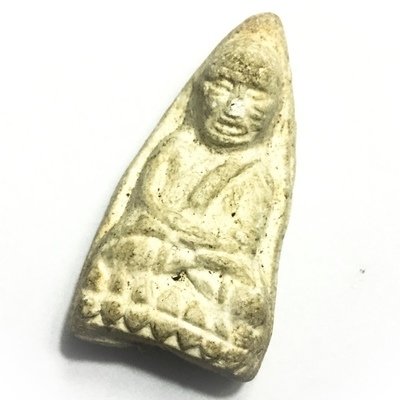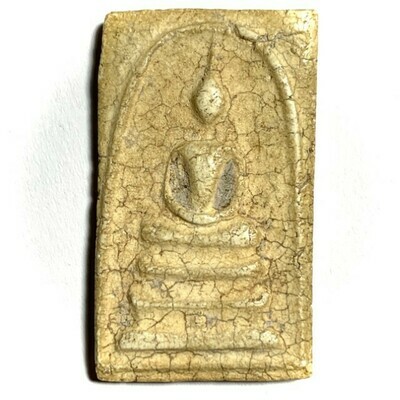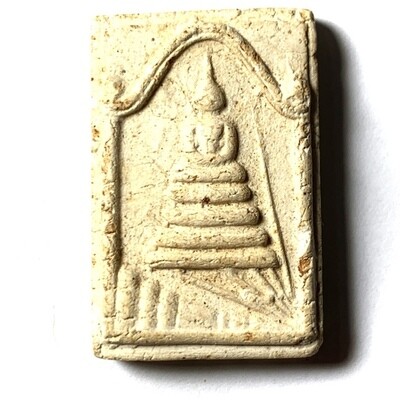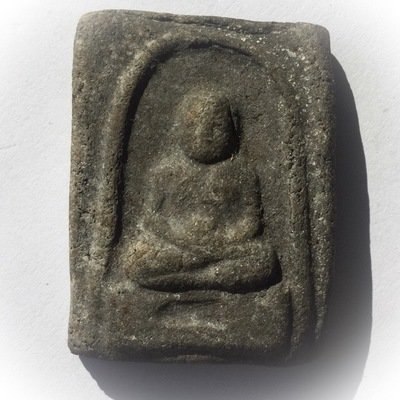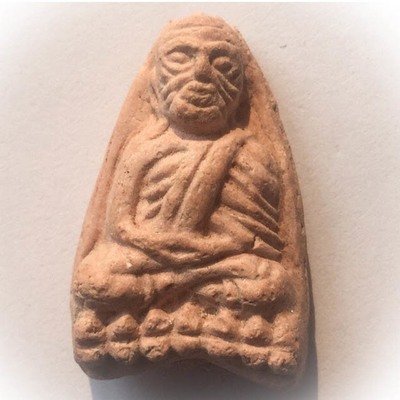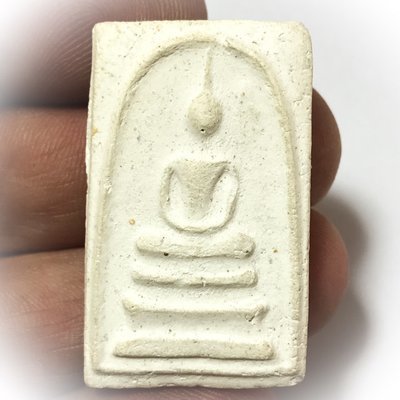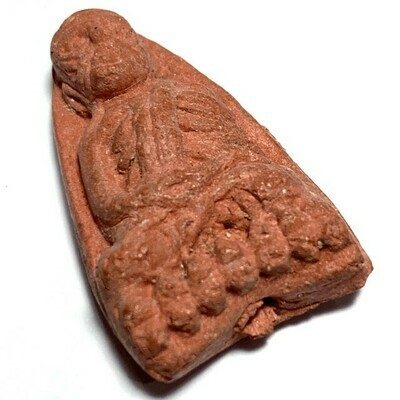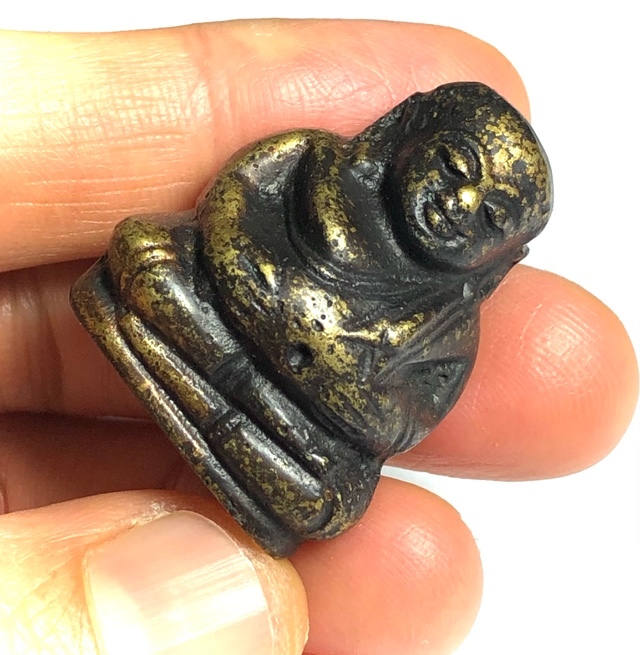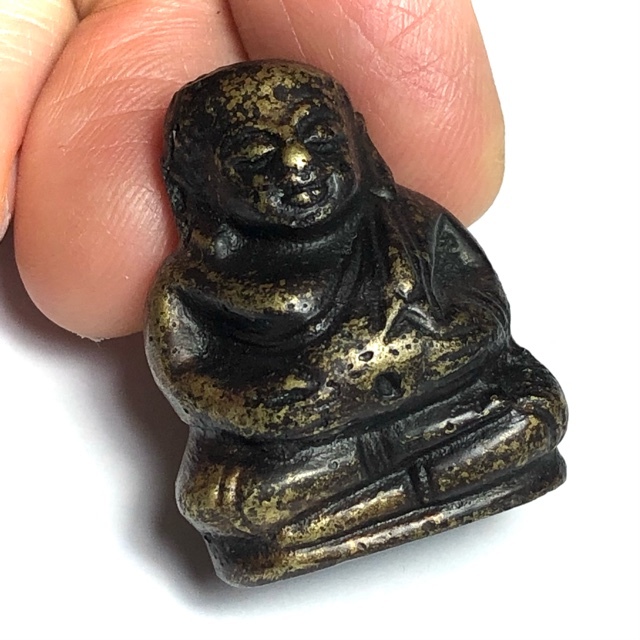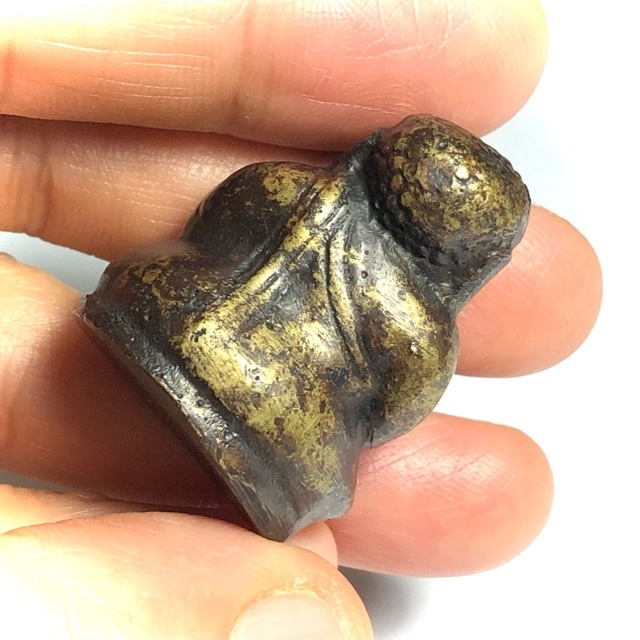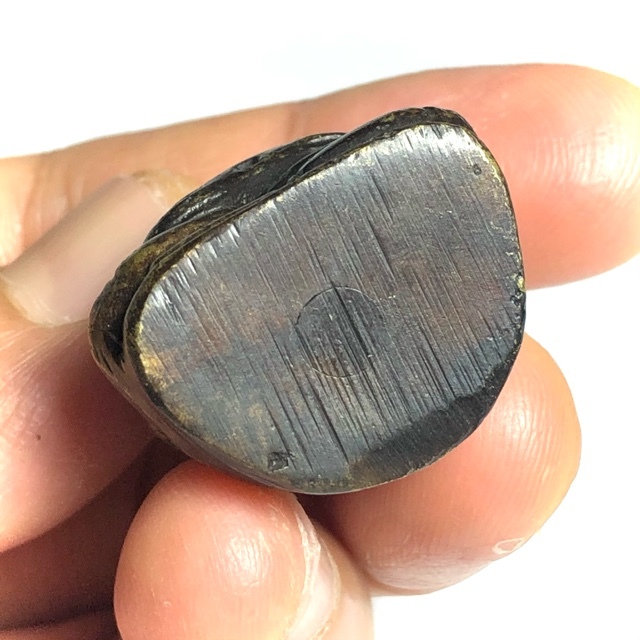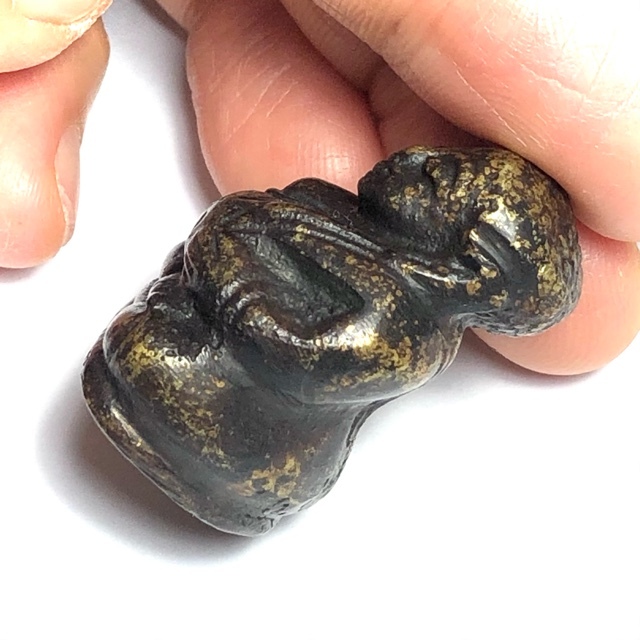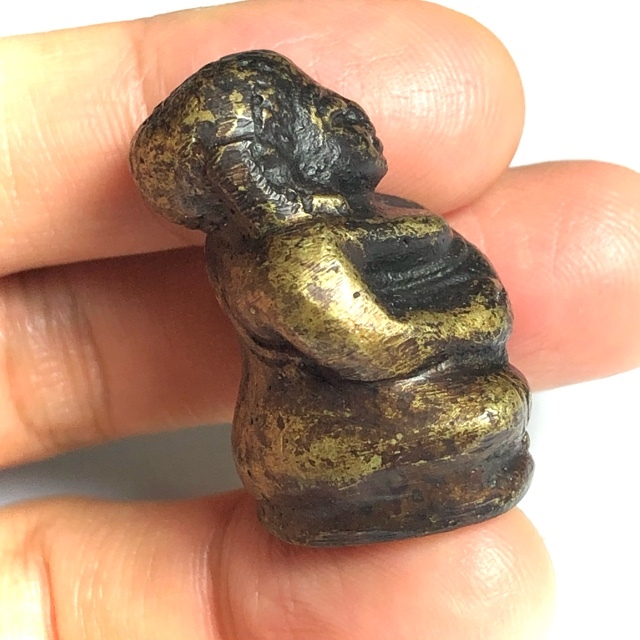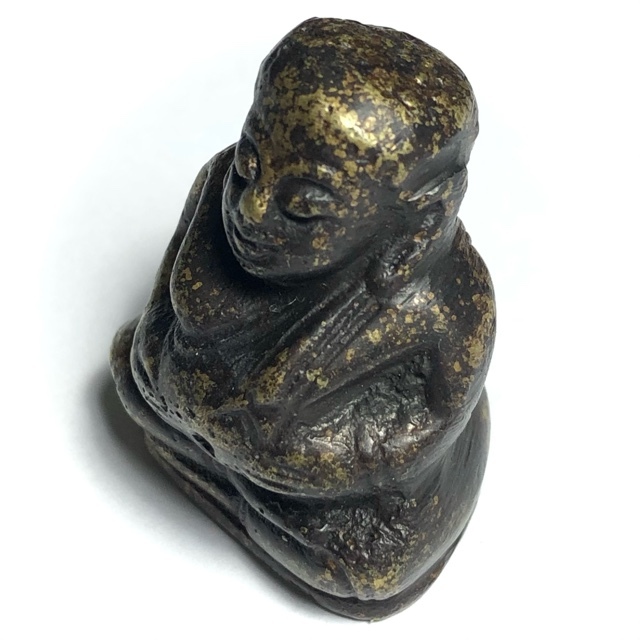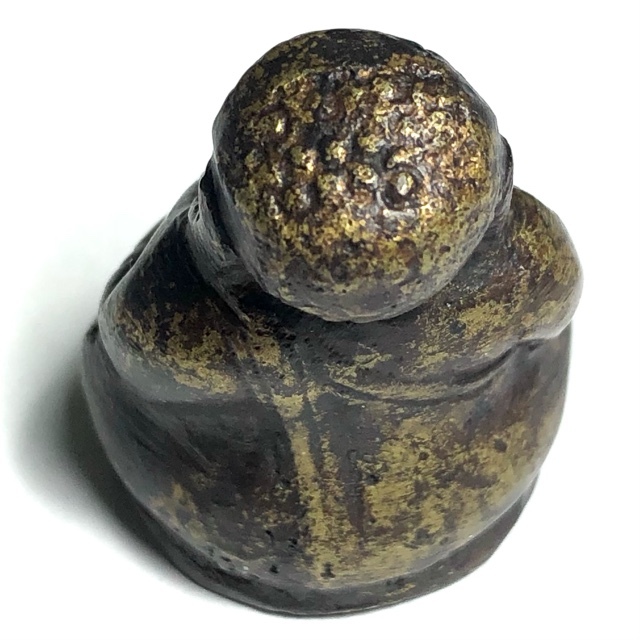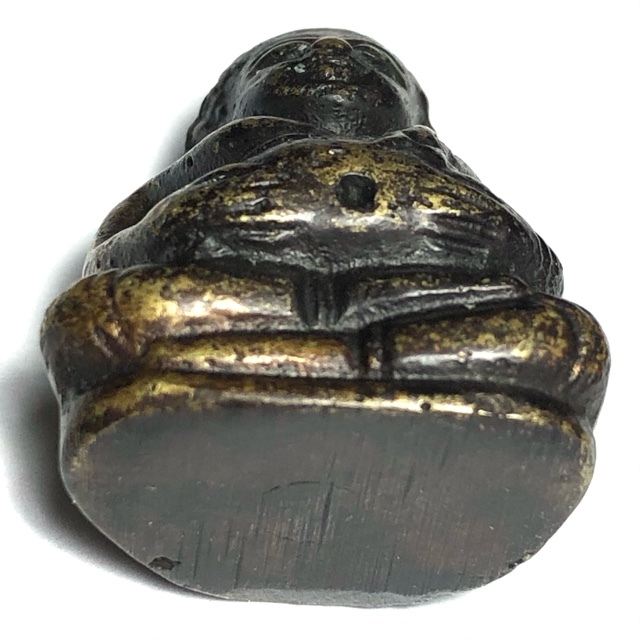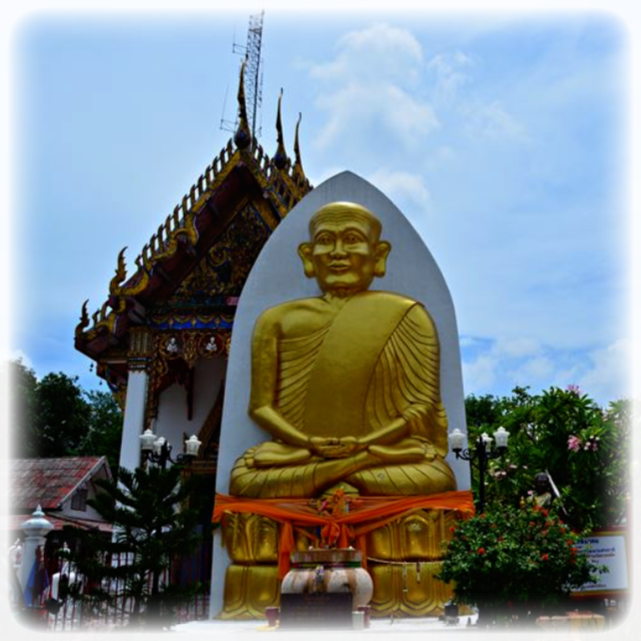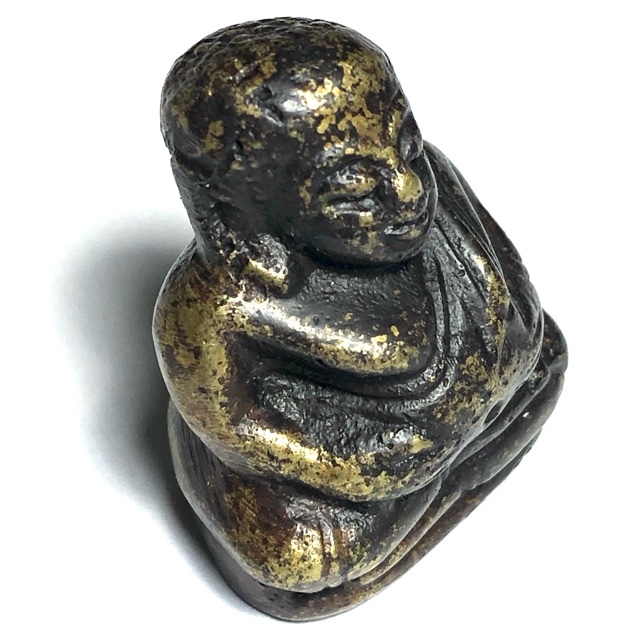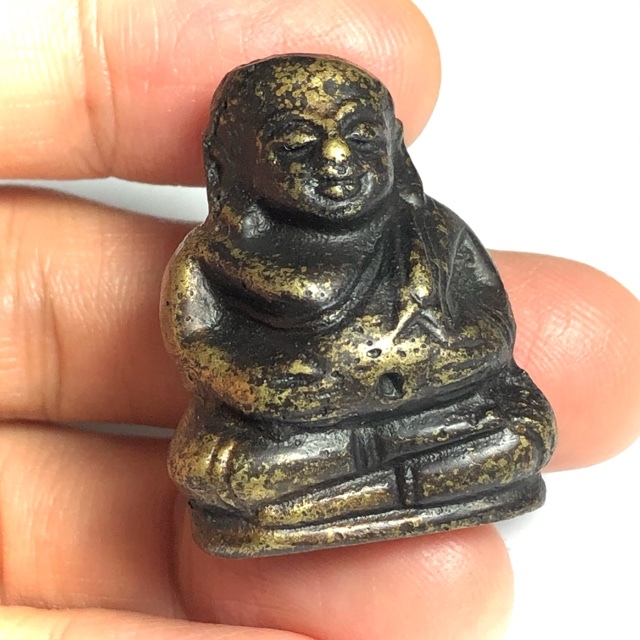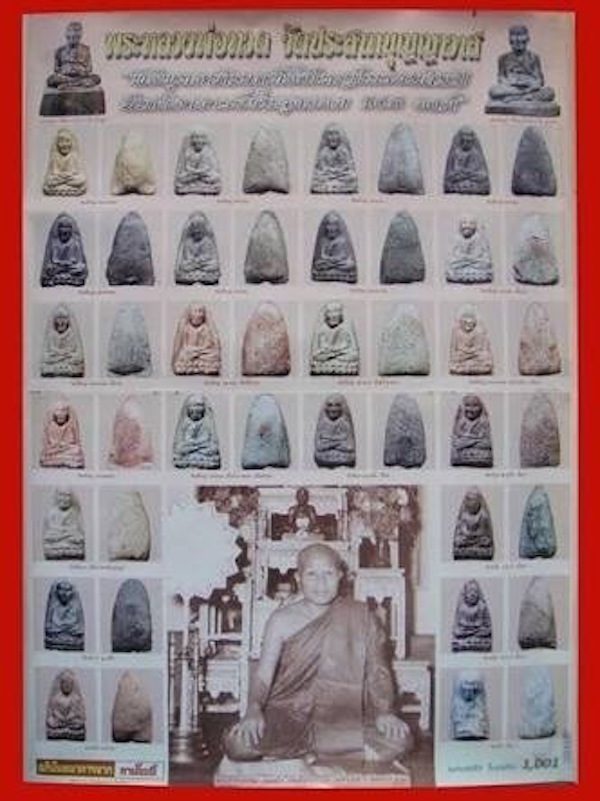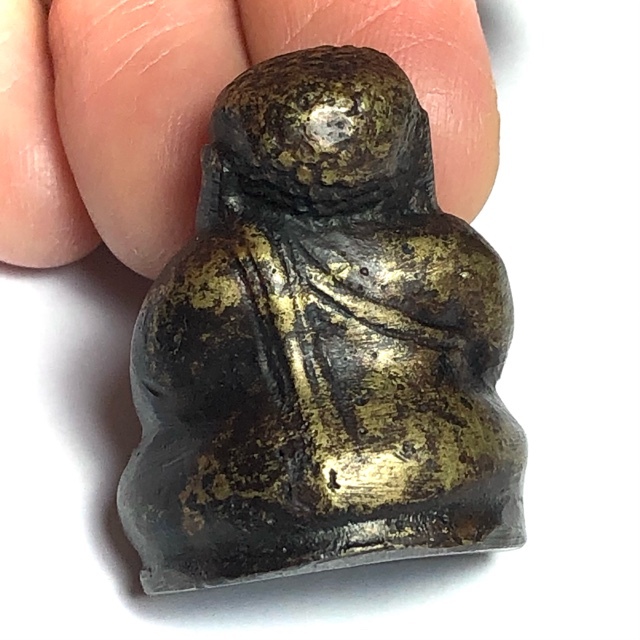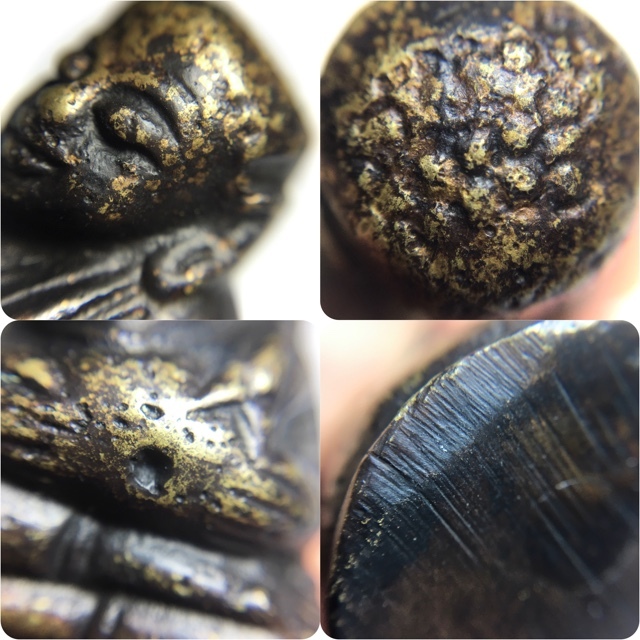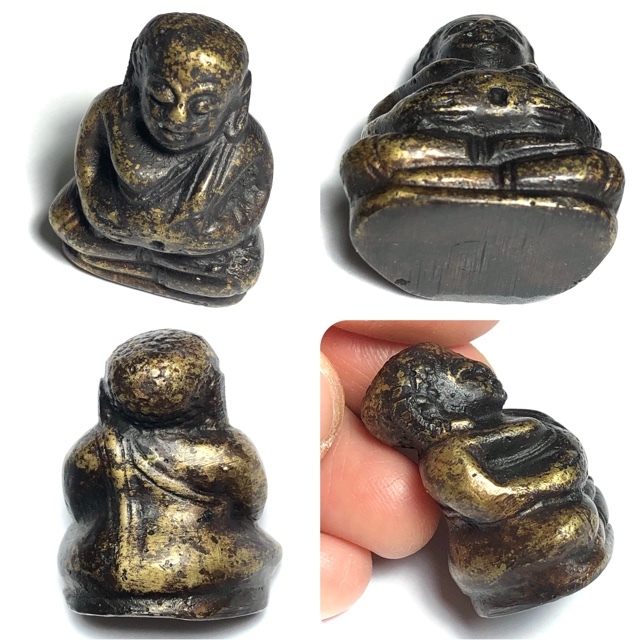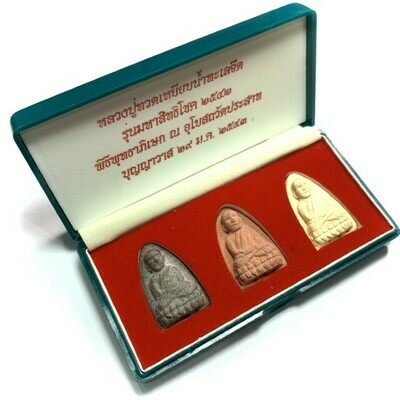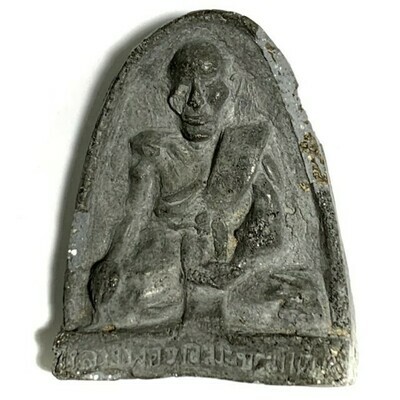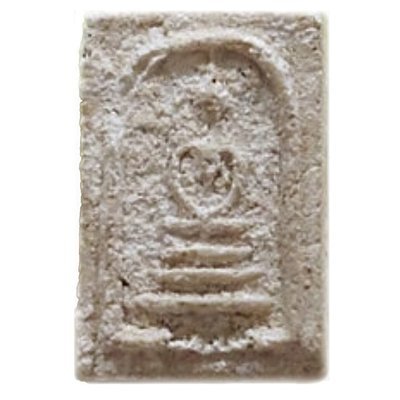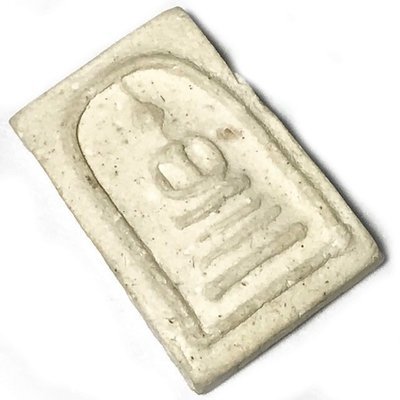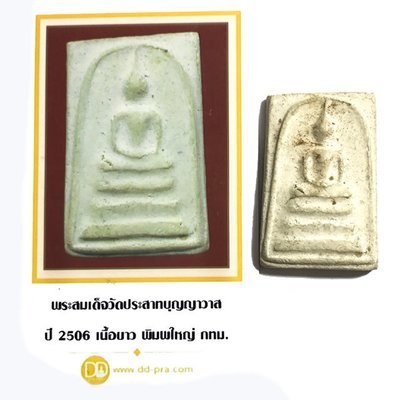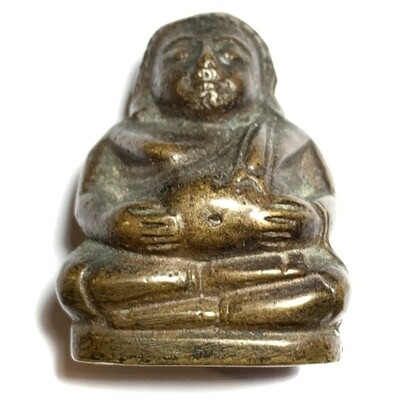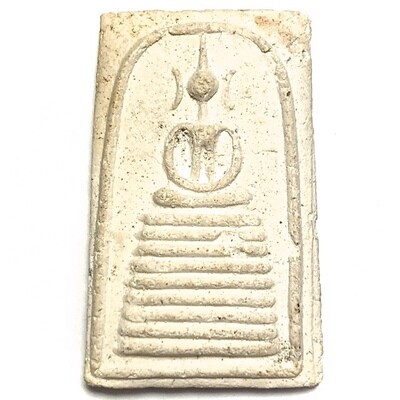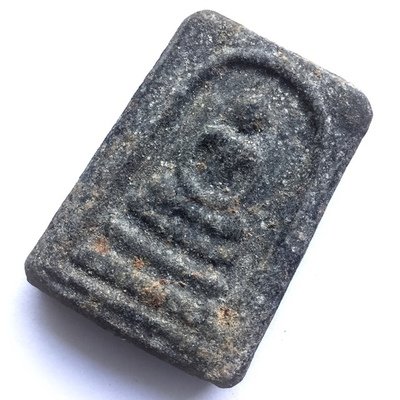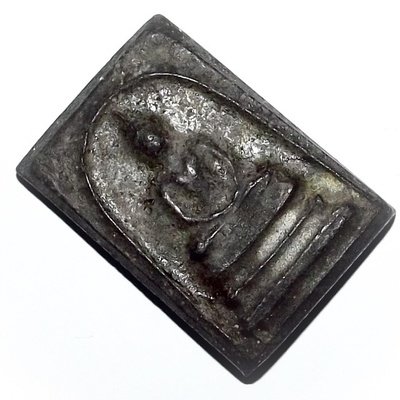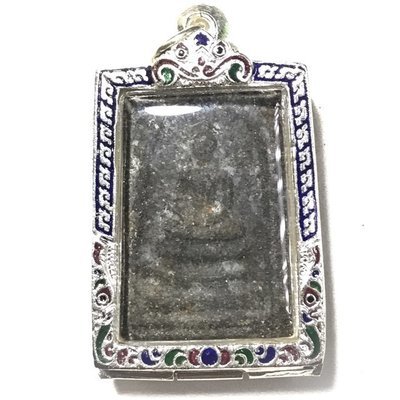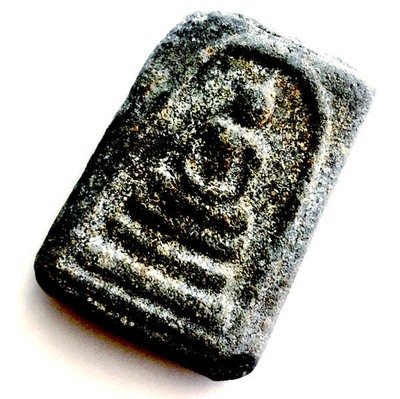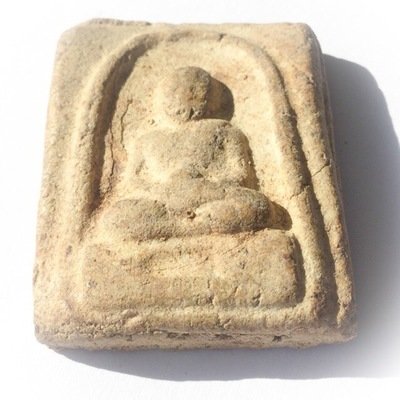Presenting a tiny but powerful and rare classic amulet from one of the Great Khao Or Masters of the 20th Century, Rian Glom Lek Hlang Chedi 2505 BE Nuea Tong Daeng Miniature Guru Monk Coin Por Tan Klai Wajasit
This Sacred amulet of the Great Khao Or Master of Nakorn Sri Tammarat, Master of Wat San Khan and Wat Pratat Noi, is a very rare amulet from Por Tan Klai’s 2505 BE Blessing Ceremony Edition, and is considered a ‘Jaek mae Krua’ type amulet (meaning ‘give to the kitchen maids and temple helpers’), which is suitable not only for men, but due to its miniature size, a perfect amulet for ladies or children to wear.

Rian Glom Lek 2505 BE Por Tan Klai Wajasit Wat Suan Khan
The 2505 BE edition of amulets of Por Tan Klai, is a highly preferred edition, which saw his famous ‘Rian Glom’ round Monk coin amulet with Chakra released, The Rian Glom Lek Hlang Chedi, and the Roop Tai Por Tan Klai Guru Monk Blesséd Photographamulets such as look om chan hmak and ya sen tobacco balls, and sacred powder amulets of various models.
A very rare and highly prized amulet for the devotees of Por Tan Klai to associate with his image and pray to him with a blessed image of the Guru, and the Chedi Relic Stupa on rear face for Buddhanussati and Marananussati. A powerful and Sacred amulet which has passed through the hands of the Guru and been blessed by him.
Por Tan Klai was one of the Top Guru Master Monks of the Last Century, and is considered one of the Four Great Masters of the Previous Generation of Lineage Masters of the Khao Or Southern Sorcery Lineage.
Kata Bucha Por Tan Klai
Roop Lor Pra Sangkajjai Pim Yai Ud Kring Nuea Samrit 2506 BE Wat Prasat Bunyawas 2 Blessings 234 Guru Monks
Pra Sanglajjai Mini Bucha statuette in Nuea Samrit Chanuan Muan Sarn with Kring Bead insert sealed into the base, from the Wat Prasat Bunyawas 2506 BE Uposadha Rebuilding Edition. This amulet was one of a plethora of amulets made with block presses donated from a multitude of temples and great Gaeji Ajarn Master Monks, to assist in the rebuilding of the Burned Uposadha Shrine Room at Wat Prasat.
The amulets were given a very Large Buddha Abhiseka Blessing Ceremony, and were made in many different types and models, many amulets being made in Sacred Powders and Metallic amulets. The Edition received 3 days and 3 nights of Chanting, from the 6th to 9th of March 2506. The second Ceremony was performed for 4 days and 4 nights, from the 13th to 15th of November 2506.
These were handed out to the congregation who came to paste to gold leaf on the Buddha image which was being installed and blessed with the Buddha Abhiseka (opening of the eyes of the Buddha ceremony). The very same ceremony also installed and consecrated a Buddha footprint image which was also installed in the temple on the same day and covered with gold leaf by the congregation.
This is one of the rarer models of the Great 2506 BE Wat Prasat Bunyawas Amulet Blessing Ceremony, known as the third largest and most historically important ceremonies in the history of Thai Buddhist Amulet making. A highly revered, and rare Sacred amulet, which was graced with the presence, and empowerment of 234 Master Monks, over two consecutive Buddha Abhiseka ceremonies.
This edition is given great notability with devotees of the 2506 BE Wat Prasat series for the high quantity of Muan Sarn Powders andf Chanuan Sacred Metals used in the series. The amulets of this edition became rare already in the first couple of years after their release, and became very rare already, and were hard to encounter as early as 2510 BE.
A Highly favored amulet, for its famously Powerful Maha Lap, Metta Maha Niyom, Maha Pokasap and Maha Sanaeh Power of the Sangkajjayana Buddha. Pra Sangkajjai represents one of the Pra Sidtisawok Aedtakka (One of the Buddha’s the most admired and praised practitioners). The Buddha praised him for his ability to put long complex teachings into short understandable formulas.
Free registered air parcel shipping worldwide is included. Pra Sangkasjjai, has a golden tinted skin complexion, and was originally so similar in appearance and stature to the Lord Buddha, that sometimes people would mistake him for the Buddha if seen from a distance. For this reason, he used his mind powers to force his body to grow fatter, and not so handsome as before, in order to not confuse others if he was the Buddha or not.
The ancient masters would often use the visual symbolism of Pra Sangkajjai’s features to create statues in this image, which has served as an important preserver of the Faith over the Centuries. Pra Sangkajjai is hence a very old form of Buddha image dating back to the early times of Buddhism. Pra Maha Sangkajjai was originally called ‘Ganjana’, which means ‘Gold’ in Pali
He was the son of a Brahman called Bpurohidtgajjayana Kodtra in the City of Usenni. He studied and completed the Traiwaet (Tri Veda). After his father passed away, he inherited the title of Bpurohidt (advisor to the King). This happened in the time of the King Jantabajjodti. Pra Sangkajjai had 7 close companions who came with himn to attend the Buddhas teachings at Wat Weluwanaram, and after listening to the Dhamma, becamse Arahants instantly and asked to ordain. In the Turasutra it is mentioned that Pra Sangkajjai lived to the age of 120 years old. Pra Sangkajjai Amulets.
The making of amulets in the image of Pra Sangkajjai have been made since ancient times by many different Temples and Samnak. The Sangkajjai amulet has always been a very preferred amulet and believed ot have great power, for the insertion of the ‘Puttakun’ qualities of the Sangkajjai Buddha of Metta Mahaniyom and Maha Sanaeh. The Wicha invokes these powers to become a Sacred Na spell within the image of the amulet.
This is a Classic Buddhist Family Heirloom type amulet, that can only increase in Sacred Value (and of course monetary value), as Time passes. The perfect collection for devotees of the Pantheon of amulets of Wat Prasat, and a perfect Set of Heirloom amulets
What are Family Heirloom Amulets?
Family Heirloom, or simply 'Heirloom' amulets, is a phrase coined by Ajarn Spencer Littlewood to translate the inherent meaning within the Thai words 'Pra Koo Baan Koo Mueang' (พระคู่บ้านคู่เมือง - Buddhist Images that are if National Buddhist Importance), and 'Pra Khong Moradok' (พระของมรดก - Historically Valuable Inheritance). By this, Ajarn Spencer means, that amulets of this kind are highly valued as items to collect and keep to pass down through all generations of one's family lineage (descendants), for them to remember the Buddha, and their own Ancestors, and carry the Merits of their Ancestors with them, as well as giving Merits back to their dead Ancestors who they inherited the amulets from.
Kata Bucha Pra Sangkajjai
Kata Hua Jai Bucha Pra Sangkajjai
Arahandti Gajjaayana Thaero Mahaa Poko Pawandtumae.
This Kata calls luck and fortune and brings wealth, and other great treasures.
Full Version Kata Bucha Pra Sangkajjai
Gajjaiyana Ja Mahaa Thaero Putto Puttaanang Puttadtang Puttanja Putta Sapaa Sidtang Puttadtang Samanubpadt-dto Puttachodtang Namaa Mihang Bpiyo Taewa Manussaanang Bpiyo Prahma Namudtamo Bpiyo Naaka Subannaanang Bpiyinsiyang Namaa Mihang Sappae Chanaa Pahuu Chanaa Bpuriso Chanaa Idthii Chanaa Raachaa Paakinii Jidt-dtang Aakajchaahi Bpiyang Ma Ma
Chanting this Kata is Good for increasing popularity, business sales and promoted status. In addition, Sangkajjai amulets have the special abstract magical quality of increasing your common sense, mindfulness and wisdom is also present within this amulet. This particular aspect of the Sangkajjai magic is what is called a ‘Prisnatam’ (mysterious phenomenon).
The 2505-2506 BE (1961) Wat Prasat Bunyawas Edition Amulets, is a universally accepted and officially recognized edition of classic Buddhist Amulets, of extremely high esteem. One reason it is so highly respected as the sacred edition of Amulets, is the fact that the creation of the sacred Muan Sarn Powders for this edition were given extreme attention to detail, and were gathered together over a long period of time, and donated from many great masters.The blessing ceremony for these Amulets is also a historically famous blessing ceremony, for its immensity, and the presence of great powerful guru monks.
The temple of Wat Prasat Bunyawas was built in 2376 BE, and was first given an official boundary and a name in 2379 BE, being first named 'Wat Klong Sam Sen', because it was located over the Sam Sen tributary canal. Its name was later changed to 'Wat Khwid', because of the 2 Sacred Giant Khwid Trees, which stood beside the Uposadha Shrine Room.Later, in the year 2498 Buddhist Era, the temple was burned in a terrible fire.
Many of the temple buildings were destroyed, including the Uposada shrine room. Pra Kroo Samuh Ampol Palawatano, the Abbot at the time, decided to build a new shrine room instead of repairing the ruins of the old one.
This was because of a seemingly miraculous event; Luang Phu Tim, the Great Guru Master Monk and Abbot of Luang Phu Tuad's Legendary Wat Chang Hai temple, had had a vision of the great Bodhisattva Luang Phu Tuad, Who appeared to him in a dream, and told him to go to Bangkok and help to repair a temple which had been burned to the ground. Luang Phu then traveled up from the south to Bangkok, and started asking around at Way Iam Woranuch, to find out if that had been a fire in any temples lately. When he heard about the great fire burning the temple down, he went to speak with the Abbot Pra Kroo Samuh Ampol. After having spoken, Luang Phu Tim presented the Abbot with some original 2505 BE Luang Phu Tuad amulets (now one of the two most famous classic top editions of millionaire Amulets of Luang Phu Tuad).
He said they should be used to press a block mold for the making of a new series of Amulets to fund the rebuilding of the shrine room and the rest of the temple. He also donated an amount of the Famously Powerful and Rare 'Din Kakyayaks' Magickal Peat Earth to use as Muan Sarn for the amulets, and some other Muan Sarn remaining from the 2497 BE first ever edition of Luang Phu Tuad amulets. These ingredients were the added to a large array of other Historically Famous Sacred Muan Sarn, including broken sacred amulets from many great Masters, and many very famous miraculous editions of classic Amulets.
Some of the more well known amulets used to break up and mix in with the sacred powders included; Pra Somdej Wat Bang Khun Prohm 2500 BE, and Pra Somdej Wat Bang Khun Prohm 2509 BE (The two most famous classic and expensive editions of Wat Bang Khun Prohm amulets). As far as the famous Luang Phu Tuad models of this edition, they were made to place 84,000 of them within the Chedi Stupa, at Wat Bunyawas (this is known as 'Kru' hiding place chamber, used to place amulets for safekeeping and folate to distribution to extend the period of the preservation of the existence of the Buddhist religion).
A Large number of extra Amulets were also made in addition to the 84,000 placed within the Chedi, to hand out to Devotees at the temple, during the blessing ceremony. The Luang Phu Tuad series was completed first and released in the year 2505 Buddhist era. As to the many other different models (such as this Pra Sangkajjai statuete) which were made, they received a second blessing and were released in the year 2506 Buddhist era.
Below; 1. Luang Phu To Wat Pradoo Chimplee. 2 - Luang Por Noi Wat Dhamma Sala, along with other Great masters at the Wat Prasat Bunyawas Blessing Ceremony 1 - Luang Phu To Wat Pradoo Chimplee 2 - Luang Por Noi Wat Dhamma Sala
Four full days and nights of chanting were performed over these amulets by the 234 monks. The ceremony was so massive that it was considered to be the largest and most important sacred blessing ceremony of Amulets, since the great 25 centuries of Buddhism ritual, in the year 2500 Buddhist era.
